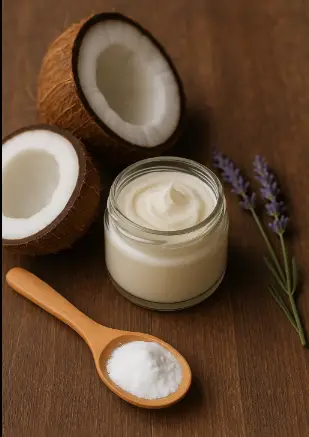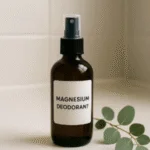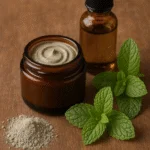Are you tired of using store-bought deodorants loaded with chemicals and leaving your skin feeling sensitive, your wallet feeling lighter, and your conscience feeling uneasy? You’re not by yourself. As more people choose natural, homemade deodorants that are safe, mild, and unexpectedly effective over conventional antiperspirants, the clean beauty movement is expanding quickly.
Discover the top 5 effective homemade deodorant recipes in this comprehensive guide, which are created to combat odor, calm skin, and leave you feeling fantastic all day. We’ll also address any of your urgent questions about turning natural, provide expert customizing advice, and explain the science underlying why these components work.
This post contains affiliate links. If you buy through these links, I may earn a small commission at no extra cost to you.
Why Use Homemade Deodorant Instead?
The majority of commercial deodorants are made using dubious substances, such as:
- Aluminum compounds: Linked in some studies to hormonal disruption and maybe breast cancer, these compounds are used to inhibit sweat glands, not merely to stop odor.
- Synthetic preservatives that imitate estrogen are called parabens.
- Artificial fragrances: Frequently proprietary mixtures that might contain endocrine disruptors or cause allergies.
- Some deodorants still include triclosan, a probable endocrine disruptor that is prohibited in hand soaps.
DIY deodorants provide the following advantages
- Skin-Friendly: No harsh chemicals, ideal for delicate underarms.
- Customizable: Adjust each batch to your preferred scent and skin type.
- Eco-friendly: No hazardous runoff and fewer plastic containers.
- Economical: Every batch lasts for weeks and costs less than $5.
- Empowering: There are no mysteries or surprises—you are in charge of what happens to your body.
Knowing How Natural Deodorants Operate
Natural deodorants do not prevent perspiration, despite what many people think. Rather, they:
- By restoring equilibrium to your underarms and eliminating microorganisms that cause odor, you can eliminate body odor.
- Use materials like clay, baking soda, or arrowroot to absorb extra moisture.
- Use botanicals and nourishing oils to soothe the skin.
Sweating is a natural way to cleanse the body. Antiperspirants that block it may prevent your body from cooling itself. Natural deodorants, on the other hand, maintain you smelling good while enabling your body to work.
How to Pick the Best Homemade Deodorant Recipes
Not every armpit is made equally. When choosing a DIY deodorant, take into account:
- Sweat level: Do you sweat a lot or not?
- Skin sensitivity: Are essential oils or baking soda safe for your skin?
- Lifestyle: Do you want a cream for daily usage or a roll-on for the gym?
- Which perfume do you prefer—citrus, flowery, earthy, or totally unscented?
We have created a wide range of formulas to suit all skin types and lifestyles. Let’s get started.
Recipe 1: Baking soda and coconut oil deodorant (strong & efficient)

Coconut Oil & Baking Soda Deodorant
Equipment
- 1 Mixing Bowl
- 1 Spoon
- 1 Container
Ingredients
- 3 tbsp Coconut Oil
- 2 tbsp Baking Soda
- 2 tbsp Arrowroot Powder
- 10 drops of Essential Oil
Instructions
- Soften Coconut Oil: Place coconut oil in a bowl and gently soften it (do not melt it) until it is smooth.
- Add Powders: Mix in the arrowroot powder and baking soda.
- Ten drops of your favorite essential oil—lavender, tea tree, lemon, or eucalyptus—should be used to add scent.
- Transfer: Use a spoon to transfer the mixture into an empty deodorant stick container or a small jar.
- Set: To make the deodorant firm, let it sit at room temperature.
Video
Notes
- Reduce baking soda to 1 tablespoon and add arrowroot to 3 tablespoons if you have sensitive skin.
- For up to three months, keep in a cool, dry location. To keep it solid in hot weather, refrigerate.
- Try a baking soda-free substitute and stop using it if skin sensitivity develops.
Ideal For:
- People Who Wear Moderate Sweaters
- Those seeking effective odor prevention
- Those that are not baking soda sensitive
Pro Tip: If the mixture seems a little grainy, either reheat it slowly and reblend it or let it sit for a few minutes to thicken.
Recipe 2: Sensitive Skin Shea Butter Deodorant
Shea Butter Deodorant for Sensitive Skin
Equipment
- 1 Mixing Bowl
- 1 Spoon
- 1 Small jar
Materials
- 3 tbsp Shea Butter
- 2 tbsp Coconut Oil
- 3 tbsp Arrowroot Powder
- 1 tsp Zinc Oxide Powder
- 10 drops of Essential Oil
Instructions
- Melt Base Ingredients: In a bowl, slowly melt the coconut oil and shea butter in quick (15-second) bursts in the microwave or double boiler.
- Add Dry Ingredients: Stir in the optional zinc oxide and arrowroot powder once it has slightly cooled.
- Fragrance Time: Use essential oils for skin benefits and a calming scent.
- Pour, then set: Pour into a deodorant stick mold or glass jar. To firm it up, let it sit at room temperature
- All Set to Go: Using your fingertips or a tiny spatula, apply a pea-sized amount to your dry.
Video
Notes
- This formula is perfect for skin types that are sensitive or inflamed because it contains no baking soda at all.
- Keep it out in a dry, cool area. Refrigeration is advised in the summer to preserve texture.
- Try using only three to five drops, or leave it out entirely, if you have an essential oil sensitivity.
It Works Best For:
- people with sensitive skin.
- After shaving, take care of
- People using natural deodorant for the first time
Pro Tip: Metal containers and utensils can deactivate the detoxifying effects of bentonite clay, so always steer clear of them when using it.
Read Also: Salted Caramel Biscuits Recipe
Recipe 3: Deodorant with Magnesium Oil Spray (no baking soda)
Magnesium Oil Spray Deodorant
Equipment
- 1 Small spray bottle
- 1 Funnel
- 1 Mixing cup
Materials
- 3 tbsp Magnesium Chloride Flakes
- ½ cup Distilled Water
- 10 drops of Essential Oil
Instructions
- Make Magnesium Oil: To make your magnesium "oil" (which isn't really an oil), put the magnesium chloride flakes in a mixing cup, add hot distilled water.
- Add Extras: If used, stir in the essential oils and witch hazel.
- Transfer: Pour the solution into a sanitized spray bottle using a funnel.
- Always give it a shake before using it. Directly apply two to three spritzes on dry, clean underarms.
Video
Notes
- It’s common to have a mild tingling feeling, particularly if your skin lacks magnesium. Use extra water to dilute if irritation occurs.
- Keep out of direct sunlight and in a cool, dry location. Shelf life: three to six months.
- Transdermal absorption allows it to be utilized as a magnesium supplement as well, which benefits both your health and cleanliness!
It works Best For:
- Those who are sensitive to baking soda.
- People who would rather use sprays than creams
- Heavy sweaters (pH is balanced by magnesium)
Pro Tip: If you are magnesium deficient, you may experience a tingling feeling. Usually, this goes away with continued use.
Recommended Products
Recipe 4: Deodorant Made of Clay for Odor Control and Detox
Clay-Based Deodorant for Detox & Odor Control
Equipment
- 1 Small glass bowl
- 1 Spoon or spatula
- 1 Airtight container
Materials
- 2 tbsp Bentonite Clay
- 2 tbsp Arrowroot Powder
- 2 tbsp Coconut Oil
- 1 tbsp Shea Butter
- 10 drops Essential Oil
Instructions
- Melt and Mix Oils: Melt the shea butter and coconut oil in a bowl until they are slightly liquefied.
- Add Dry Ingredients: Mix the oils with arrowroot powder and bentonite clay.
- Add Essential Oils: For extra fragrance and antimicrobial qualities.
- Store: Transfer the paste with a spoon into a jar or sealed glass container.
- Use: Using clean fingertips or a little spatula, apply a pea-sized amount to each underarm.
Video
Notes
- Non-Metal Tools: Why? When bentonite clay comes into contact with metal, it becomes less effective. Use wood, glass, or plastic tools at all times.
- Detox Phase: You can experience a detox phase if you’re moving away from commercial deodorants. This is typical! Clay aids in removing pollutants that aluminum-based antiperspirants have retained.
- Keep it out in a dry, cool area. In warm weather, if it melts, place it in the refrigerator until it solidifies again.
Who It’s Ideal For:
- Individuals giving up conventional deodorants
- People who are prone to odors
- Anyone in need of a natural cleanse?
Pro Tip: Add a few drops of jojoba oil if the mixture is too thick. Add extra clay if it is too thin.
Read Also: Heavenly Easter Swirl Pie Recipe
Recipe 5: Witch Hazel & Aloe Vera Roll-On Deodorant
Witch Hazel & Aloe Vera Roll-On Deodorant
Equipment
- 1 Small mixing bowl
- 1 Spoon or mini whisk
- 1 Empty roll-on bottle
Materials
- 2 tbsp Witch Hazel
- 2 tbsp Aloe Vera Gel
- 1 tsp Baking Soda
- 10 tsp Vegetable Glycerin
Instructions
- Mix Liquids: In a dish, thoroughly mix aloe vera gel.
- Add Dry Ingredient: If using, stir in baking soda. Although it strengthens the anti-odor properties.
- Essential Oils: For aroma and antibacterial properties, add your preferred skin-safe.
- Optional Add-ins: To improve moisture retention, stir in vegetable glycrin.
- Transfer: Fill a clean roll-on bottle with the liquid using a pipette or tiny funnel.
Video
Notes
- Ideas for Custom Fragrances: Combine lemon and tea tree for antibacterial freshness or lavender and chamomile for a soothing aroma.
- Storage: Keep out of direct sunlight. Use within two months.
Who It Works Best For:
- Skin that is sensitive or recently shaven
- The summertime
- Those who don’t like thick textures
FAQs
Is daily usage of homemade deodorant safe?
Yes, provided that the substances are pure and safe for the skin. Before using anything for the first time, always do a patch test, especially if your skin is sensitive.
Will using homemade deodorant still cause me to perspire?
Yes. These solutions absorb moisture and eliminate odor without blocking sweat glands. Sweating is a normal and essential bodily process.
How long is the shelf life of homemade deodorant?
The majority of recipes can be kept for three to six months in a cold, dry location. If your house is particularly warm, put it in the refrigerator.
Are these recipes adaptable?
Absolutely. You can change the foundation ingredients to your liking, swap oils, or select your preferred essential oil blend.
Read Also: Best 5 Transfusion Drink Recipes
The Best Ways to Transition to Natural Deodorant
- During the Detox Phase: Your body may need a week or two to adjust. For a while, you might notice an increase in wetness or odor.
- Exfoliate: To get rid of residue and dead skin, gently exfoliate your underarms once a week.
- Remain hydrated: Body odor can be naturally reduced with a balanced diet and adequate hydration.
- Wear breathable clothing: Cotton and linen minimize perspiration and assist in controlling body temperature.
Conclusion: Savor the Organic Freshness
Making your deodorant at home is about more than simply staying away from bad components; it’s about taking back control of your skincare routine and reestablishing a connection with your body’s natural cycles. These recipes provide a sustainable, efficient, and fulfilling substitute for store-bought deodorants, regardless of your level of experience with do-it-yourself projects or your passion for eco-friendly cosmetic products.
- Keep in mind that natural deodorants can be customized.
- They will control odor, but they won’t stop perspiration.
- Doing it yourself is powerful, economical, and better for the environment and your skin.








